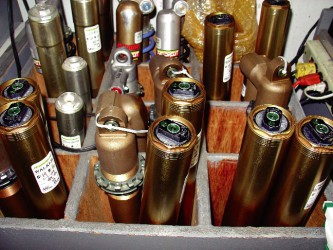 Ef svo er ekki, þá væri gott hjá þér að byrja á því núna. Það er mun stærra atriði hvernig fjöðrun virkar á hjólinu heldur en hversu kraftmikið hjólið er. Ójafnvægi í uppsetningu á föðruninni getur gert það að verkum að hjólið höndlar ömurlega. Gömul olía á dempurum er líka stór orsakavaldur ef fjöðrun virkar illa. Við rændum hér nokkrum punktum frá MXA vefnum um hvernig þeir ráðleggja uppsetningu. Treystum því að engilsaxneskan vefjist ekki fyrir ykkur. Ef þið treystið ykkur ekki til að stilla hjólin þá eru nokkrir snillingar sem vinna við það. Bara spyrja næsta reynda hjólamann um hver er bestur.
Ef svo er ekki, þá væri gott hjá þér að byrja á því núna. Það er mun stærra atriði hvernig fjöðrun virkar á hjólinu heldur en hversu kraftmikið hjólið er. Ójafnvægi í uppsetningu á föðruninni getur gert það að verkum að hjólið höndlar ömurlega. Gömul olía á dempurum er líka stór orsakavaldur ef fjöðrun virkar illa. Við rændum hér nokkrum punktum frá MXA vefnum um hvernig þeir ráðleggja uppsetningu. Treystum því að engilsaxneskan vefjist ekki fyrir ykkur. Ef þið treystið ykkur ekki til að stilla hjólin þá eru nokkrir snillingar sem vinna við það. Bara spyrja næsta reynda hjólamann um hver er bestur.
(1) Setting sag is the one thing that every rider thinks he can do, but normally does wrong. Here are some tips: First, do not measure the sag with the rider standing up. Sit down. Second, bounce on the suspension before measuring. Third, sit where you actually ride, not some dream position that you think looks impressive. Fourth, measure in line with the arc of the rear wheel. Do not measure straight up and down. The rear wheel rotates forward. Measure in a line that approximates the wheel’s arc.
(2) Static sag is a measurement of how much the bike sags under its own weight. Static sag can only be checked after race sag is set. Static sag should be between 30mm and 40mm on big bikes. If you have more than 40mm of static sag, your shock spring is too stiff. Less than 30mm and your spring is too soft.
(3) Sticky linkage ruins your suspension. Grease your bike’s steering head, shock linkage and swingarm pivot periodically. This is the best way to ensure that every part is working to its fullest. Pressure washers and mud races can get past even the best seals.
(4) Keep your steering head bearing tight enough that the front end doesn’t flop over by itself. It should have to be pushed slightly before it moves. Your steering head bearing is a cheap steering damper. Use it.
(5) Lots of suspension problems are caused by incorrect tire pressure. If your suspension or handling feels funny, go back to the pits and check your tire pressure. Too much pressure makes the suspension stiff and too little makes the bike wallow and push.
(6) To make your forks stiffer (for free) add oil. To make them softer, remove oil. How can you do this without sending your forks to a tuner? A good-quality syringe (with a tip on it) will allow you to squirt 5cc to 10cc of oil through the fork air bleed screw. This reduces the air space and makes the forks firmer at the end of the stroke. To remove oil, remove the forks’ air bleed screw, take the forks off the bike and turn them upside-down to let 5cc to 10cc of oil dribble out into a container.
(7) All forks build up air pressure internally. The more air in the forks, the stiffer they will feel. To bleed the air out of your forks, you need to make sure that the front wheel is off the ground and that the forks are completely cooled off from riding. They need to be cool so that air pressure built up from heat expansion can return to normal before you try to bleed them. If you forget either of the two steps before opening your bleed screw, you run the risk of creating a vacuum in your forks?which is the opposite of what you set out to do.
(8) It is critical that your front axle not bind in the fork legs. Most modern front axles accept a 19mm Allen socket. Buy one. When installing the front wheel, just hold the nut with a wrench and turn the axle with the 19mm Allen. Once you have the axle tight, tighten the fork dropout’s pinch bolts. By spinning the axle in, instead of spinning the nut on, you guarantee that the axle is not bound up in the dropouts.
(9) Axle blocks have over 20mm of adjustment, and depending on whether your rear wheel is all the way forward or all the way back, your shock will react differently. When the rear wheel is all the way forward, there is less leverage on the shock. It will make the suspension feel stiffer. Mounting the wheel farther back will soften the shock. Short riders will have the best luck with moving the rear wheel back. Short riders position their bodies farther forward on the chassis and benefit from the increased leverage of the rear wheel.
(10) Forks that are too soft dive excessively under deceleration and ride on the firmest part of the fork’s damping system. This makes them feel stiff. When the rider notices how stiff his forks feel, he naturally turns the clickers out to soften the forks. This obviously makes the situation worse. Forks that are too soft feel stiff?when in reality, they need to be stiffer to feel softer. Repeat that three times.
 Ef svo er ekki, þá væri gott hjá þér að byrja á því núna. Það er mun stærra atriði hvernig fjöðrun virkar á hjólinu heldur en hversu kraftmikið hjólið er. Ójafnvægi í uppsetningu á föðruninni getur gert það að verkum að hjólið höndlar ömurlega. Gömul olía á dempurum er líka stór orsakavaldur ef fjöðrun virkar illa. Við rændum hér nokkrum punktum frá MXA vefnum um hvernig þeir ráðleggja uppsetningu. Treystum því að engilsaxneskan vefjist ekki fyrir ykkur. Ef þið treystið ykkur ekki til að stilla hjólin þá eru nokkrir snillingar sem vinna við það. Bara spyrja næsta reynda hjólamann um hver er bestur.
Ef svo er ekki, þá væri gott hjá þér að byrja á því núna. Það er mun stærra atriði hvernig fjöðrun virkar á hjólinu heldur en hversu kraftmikið hjólið er. Ójafnvægi í uppsetningu á föðruninni getur gert það að verkum að hjólið höndlar ömurlega. Gömul olía á dempurum er líka stór orsakavaldur ef fjöðrun virkar illa. Við rændum hér nokkrum punktum frá MXA vefnum um hvernig þeir ráðleggja uppsetningu. Treystum því að engilsaxneskan vefjist ekki fyrir ykkur. Ef þið treystið ykkur ekki til að stilla hjólin þá eru nokkrir snillingar sem vinna við það. Bara spyrja næsta reynda hjólamann um hver er bestur.